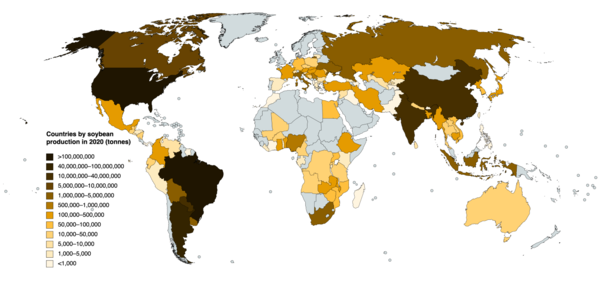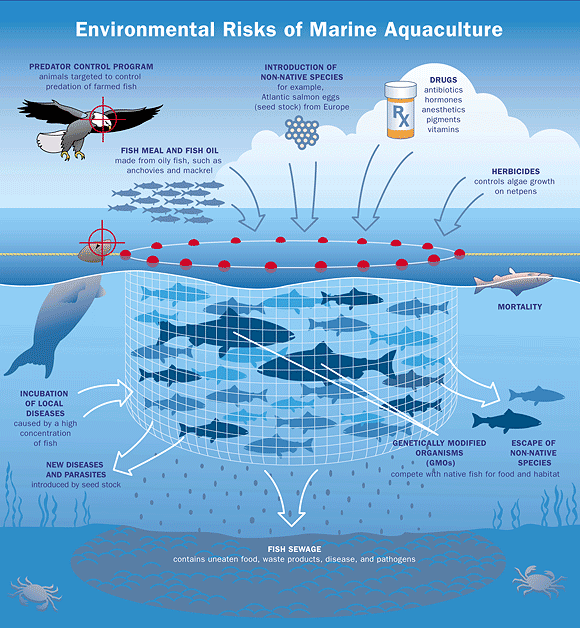Chapter 10: Agricultural and Food Systems
10.9 Environmental Impact of Agriculture
No one argues with the understanding that agriculture, and increasingly aquaculture, are essential to supplying our food to sustain the world’s population. Farming is also the world’s largest industry, employing over one billion people and generating over one trillion dollars’ worth of food annually. And it’s the largest driver of habitat and biodiversity loss around the world.

Source: “Countries by soybean production in 2020” by JackintheBox via Wikimedia Commons is licensed under CC BY-SA 4.0.

Source: “Indonesia Malaysia Locator” derivative work: Gunkarta (talk) via Wikimedia Commons is licensed under CC BY-SA 2.5.
10.9.1 Habitat and biodiversity loss
Agricultural ecosystems provide important habitats for many wild plant and animal species. This is especially the case for traditional farming areas that cultivate diverse species. However, rising demand for food and other agricultural products has seen the large-scale clearing of natural habitats to make room for intensive monocultures. Recent examples include the conversion of lowland rainforests in Indonesia to oil palm plantations, and of large areas of the Amazon rainforest and Brazilian savanna to soybean and cattle farms. This ongoing habitat loss threatens entire ecosystems as well as many species. Expanding palm oil plantations in Indonesia and Malaysia, for example, pose the most significant threats to endangered megafauna including Asian elephant, Sumatran rhinoceros, and tigers.

Source: “Aquaculture production (2019)” by Food and Agriculture Organization via Wikimedia Commons is licensed under CC BY-SA 3.0.
Aquaculture is also in direct competition with natural marine and freshwater habitats for space. For example, marine fish farms often need the shelter of bays and estuaries to avoid damage from storms and currents. In addition, farmed fish need good water quality, frequent water exchange, and other optimal environmental conditions. But these locations are also very often ideal for wild fish and other marine life. Some European fish farms have been placed in the migratory routes of wild salmon, while in Asia and Latin America, mangrove forests have been cleared to make space for shrimp farms.

Source: “Aquaculture: The Evironmental Impact.” Mother Jones, WordPress.com, 1 March 2006, http://www.motherjones.com/environment/2006/03/aquaculture-environmental-impact/
10.9.2 Desertification
On top of habitat loss due to clearing, unsustainable agricultural practices are seeing 12 million hectares of land lost each year to desertification. Desertification is land degradation in arid, semi-arid and dry sub-humid areas resulting from climatic variations and human activities-major drivers of climate change in general. Desertification is potentially the most threatening ecosystem change impacting livelihoods of the poor. Persistent reduction of ecosystem services as a result of desertification links land degradation in drylands to loss of human well-being. When natural vegetation is cleared, and when farmland is plowed, the exposed topsoil is often blown away by the wind or washed away by rain.
10.9.3 Erosion
Erosion due to soy production, for example, results in Brazil losing 55 million tons of topsoil every year. This leads to reduced soil fertility and degraded land. Other major crops that cause soil erosion include coffee, cassava, cotton, corn, palm oil, rice, sorghum, tea, tobacco, and wheat.
Water resources are also impacted by modern agriculture. Globally, the agricultural sector consumes about 70% of the planet’s accessible freshwater and many big food producing countries like the US, China, India, Pakistan, Australia and Spain have reached, or are close to reaching, their renewable water resource limits.
The main causes of wasteful and unsustainable water use are:
- leaky irrigation systems
- wasteful field application methods
- cultivation of thirsty crops not suited to the environment.
Unsustainable water use can harm the environment by changing the water table and depleting ground water supplies. Studies have also found that excessive irrigation can increase soil salinity and wash pollutants and sediment into rivers – causing damage to freshwater ecosystems and species as well as those further downstream, including coral reefs and coastal fish breeding grounds. Soil carried off in rain or irrigation water can lead to sedimentation of rivers, lakes and coastal areas. The problem is exacerbated if there is no vegetation left along the banks of rivers and other watercourses to hold the soil.
10.9.4 Sedimentation
Sedimentation causes serious damage to freshwater and marine habitats, as well as the local communities that depend on these habitats. For example, people living in Xingu Indigenous Park in Brazil report declines in fish numbers. This trend is attributed to changes in the courses of waterways resulting from farming-related erosion and the silt deposition this causes. In Central America, plantation soil run-off ends up in the sea, where it affects the Meso-American Reef. It’s not just the eroded soil that is damaging: pesticides and fertilizers carried in rainwater, and irrigation runoff can pollute waterways and harm wildlife.
The use of pesticides, fertilizers, and other agrochemicals has increased enormously since the 1950s. For example, the amount of pesticide sprayed on fields has increased 26-fold over the past 50 years. These chemicals don’t just stay in the fields they are applied to. Some application methods – such as pesticide spraying by airplane – lead to pollution of adjacent land, rivers or wetlands. Pesticides often don’t just kill the target pest. Beneficial insects in and around the fields can be poisoned or killed, as can other animals eating poisoned insects. Pesticides can also kill soil microorganisms. In addition, some pesticides are suspected of disrupting the hormone messaging systems of wildlife and people, and many can remain in the environment for generations.
10.9.5 Eutrophication
Unlike pesticides, fertilizers are not directly toxic. However, their presence in freshwater and marine areas alters the nutrient system, and in consequence the species composition of specific ecosystems. Their most dramatic effect is eutrophication – resulting in an explosive growth of algae due to excess nutrients. This depletes the water of dissolved oxygen, which in turn can kill fish and other aquatic life. Food production is one of the primary causes of biodiversity loss through habitat degradation, overexploitation of species such as overfishing, pollution and soil loss Even though its environmental impacts are immense, the current food system is expected to expand rapidly to keep up with projected increases in population, wealth and animal-protein consumption.

